Digital signature tools are essential in modern business, but finding the right fit is a challenge when there are so many competitors on the market.
For enterprise organizations and large teams, both DocuSign and Nintex eSign (formerly AssureSign) stand out as two viable candidates.
DocuSign is a leading contender in the e-signing space and offers a great combination of features, scalability, and integrations.
On the other hand, Nintex eSign is part of the Nintex platform, which styles itself as an end-to-end, complete solution for workflow automation.
So, which one is actually a better choice? In this article, we’ll tell you what we know about both platforms so that you can determine if they make sense for your organization.
Key takeaways
- DocuSign is focused entirely on the e-signing process. The platform offers a huge selection of integrations but is largely limited to a drag-and-drop interface for digital signature capture.
- Nintex eSign is primarily intended for use with other tools within the Nintex ecosystem and is typically pitched as a supplemental add-on.
- Competitive solutions like PandaDoc, Proposify, GetAccept and others can provide more expansive solutions around digital signatures and document generation.
Nintex eSign
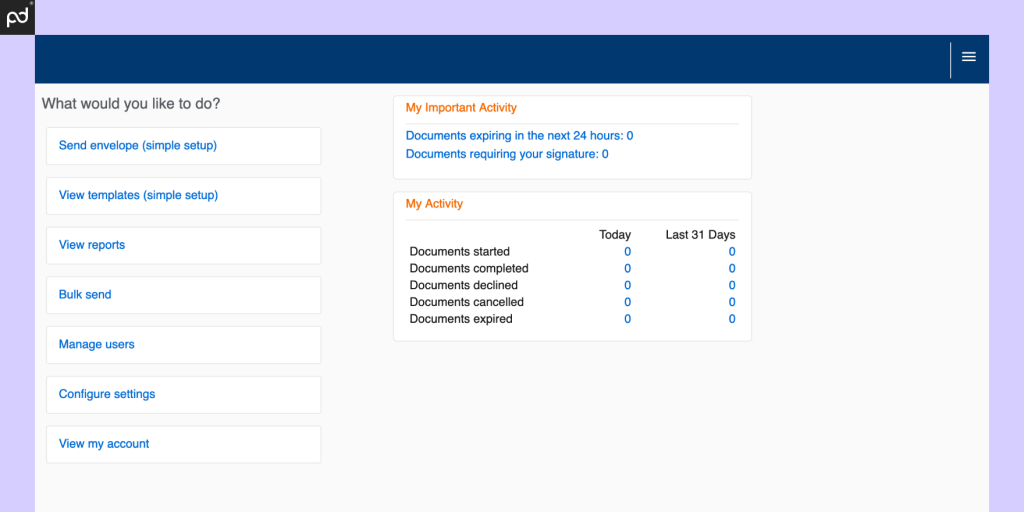
Pricing: Not disclosed.
Ease of use: 8.1/10
Free trial: Yes; 30 days.
Support: Knowledge base; support tickets; additional support varies by plan.
Nintex eSign (formerly AssureSign) is a powerful e-signing solution that has been seamlessly integrated into the broader Nintex Process Platform.
This software streamlines document signing by enabling users to securely prepare, send, and sign electronic documents.
Within the Nintex ecosystem, this software plays a crucial role in automating and accelerating document-centric processes.
It integrates with Automation Cloud and DocGen, two other Nintex solutions, in order to create a single, unified document process.
However, Nintex eSign is largely industry agnostic.
Similar to most e-signing platforms, it can cater to a variety of roles, including HR onboarding, contract management, and sales agreements, making it a valuable addition to Nintex users of every stripe.
DocuSign
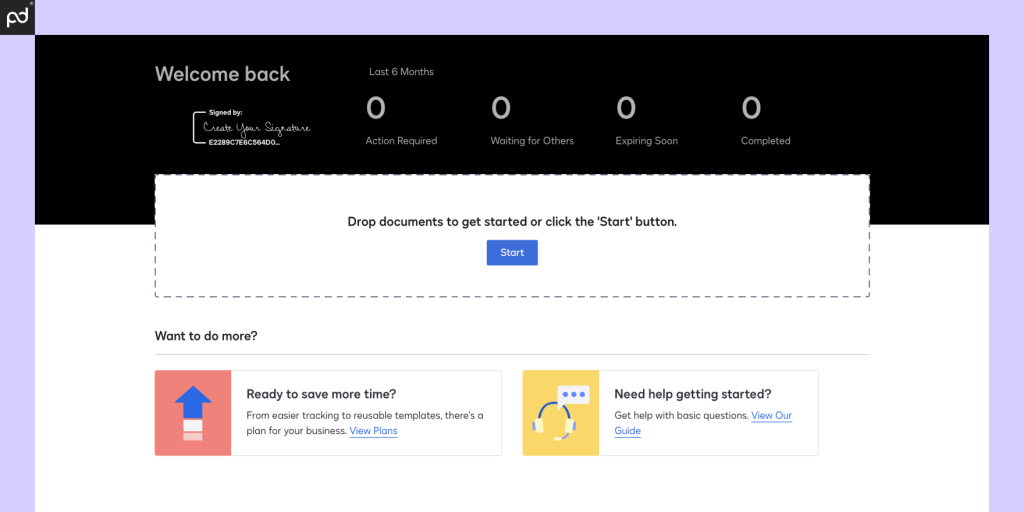
Pricing: Personal ($15); Standard ($45); Business Pro ($60). Enterprise pricing available. All pricing based on month-to-month commitment.
Ease of use: 9.0/10
Free trial: Yes; 30 days.
Support: Knowledge base; support tickets; additional support plans sold as separate packages.
DocuSign is one of the most recognizable names in the e-signature space.
The platform caters to a broad spectrum of users — from individuals to large enterprises — and is known for its straightforward and user-friendly approach to digital signature acquisition.
While its e-signing platform is largely considered a standalone product, DocuSign also offers a suite of tools to assist with document generation, contract lifecycle management, and user collaboration.
This comprehensive approach makes it a popular choice for businesses seeking to digitize and optimize their document-related processes.
For e-signing, DocuSign offers an extensive suite of integrations with popular business platforms,including Salesforce, Microsoft, Google, and others.
That, combined with its robust security measures and industry compliance ensure that electronic signatures are legally valid and protected.
Nintex eSign vs DocuSign at a glance
Both DocuSign and Nintex offer broad similarities in their feature set, but they differ in key areas.
Here’s a closer look at the top plans offered by both platforms.
| Plan Details | DocuSign | Nintex eSign |
|---|---|---|
| Core product | ||
| E-signature capture | ✓ | ✓ |
| Real-time audit trail | ✓ | ✓ |
| Notifications | ✓ | ✓ |
| Language support | ✓ | ✓ |
| Mobile app | ✓ | X |
| Reporting tools | ✓ | ✓ |
| E-signing features | ||
| Signing order | ✓ | ✓ |
| Send to multiple recipients | ✓ | ✓ |
| Bulk send | ✓ | ✓ |
| In-person signing | ✓ | ✓ |
| Collaboration tools | ✓ | ✓ |
| Signer attachments | ✓ | ✓ |
| Payment gateway | ✓ | X |
| Document prep | ||
| Drag & drop fields (PDF) | ✓ | ✓ |
| Create reusable templates | ✓ | ✓ |
| From-scratch document builder | X | X |
| Pre-built template library | X | X |
| Form creation | ✓ | X |
| Custom branding | ✓ | ✓ |
| Integrations & API | ||
| Import & storage | ✓ | X |
| CRM | ✓ | Limited |
| Productivity | ✓ | X |
| API | ✓ | ✓ |
| Support | ||
| Email / ticketing support | ✓ | ✓ |
| Chat support | ✓ | Varies by plan |
| Knowledge base | ✓ | ✓ |
| Phone | ✓ | Varies by plan |
| Premium support options | $ | X |
For this chart, we’ve compared DocuSign’s Enhanced (enterprise) plan with the functionality offered by Nintex eSign.
While both providers offer the ability to sign documents, these electronic signature solutions also have some restrictions that aren’t immediately evident.
- Both providers have transaction limits that will restrict the number of documents users can send.
- Neither e-signature solution offers document generation, and DocuSign’s form creation is limited.
- Both solutions assume you’ll be working with other software, whether it’s another branded product or a third-party solution like Salesforce.
While we’ll dive into each issue more deeply in the next section, it’s important to note right up front that neither DocuSign or Nintex intend their e-signing platforms to be more than an electronic signature solution.
That might seem obvious, but keep in mind that there are a broad selection of tools in the e-signing space (PandaDoc, Proposify, Qwilr, etc.) that assist with signature capture while covering additional use cases.
Requirements, workflows & pricing
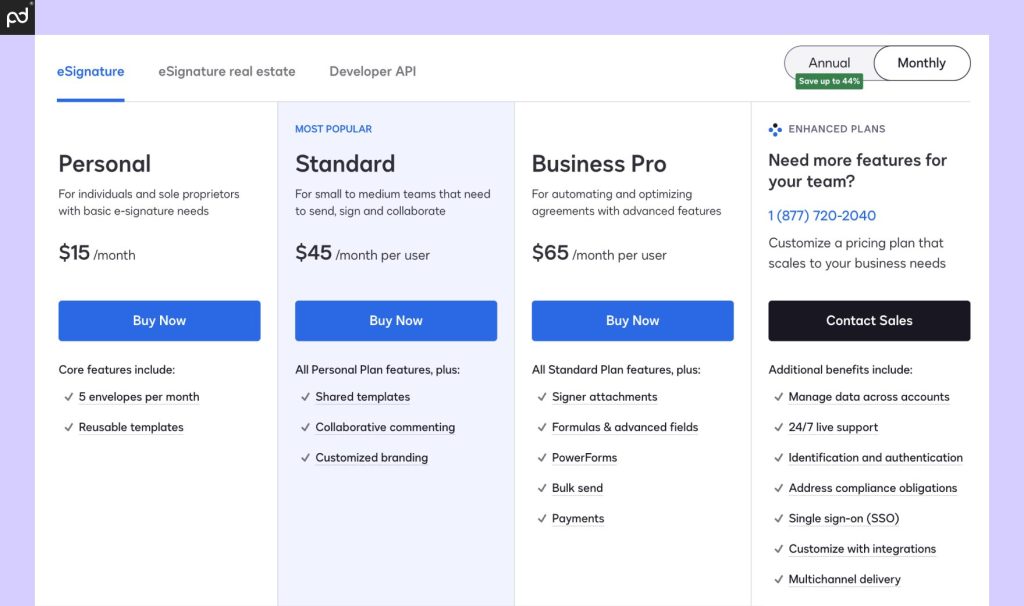
While both DocuSign and Nintex eSign offer powerful e-signing solutions, the context and terms around both services varies greatly.
The other tools in your tech stack will play a major role in which of these software solutions is a better fit.
To start, DocuSign offers one of the most scalable and wide-ranging digital signature solutions on the market.
Lower-end plans are great for small businesses who need an electronic signature software, with most plans supporting up to 50 users. (The company also offers unique real estate plans for realtors and realty firms.)
As an e-signing platform, DocuSign is typically considered an industry standard. However, its 100 envelope per user/year usage means that this platform may not be the most cost-effective option for power users.
It’s possible to raise the document cap by working with the sales team, but doing so will incur an additional charge.
However, compared to Nintex eSign, those prices and limitations may seem inconsequential.
Given that Nintex is designed as a complete end-to-end platform targeting enterprise businesses, it likely comes as no surprise that the onboarding price is considerably higher.
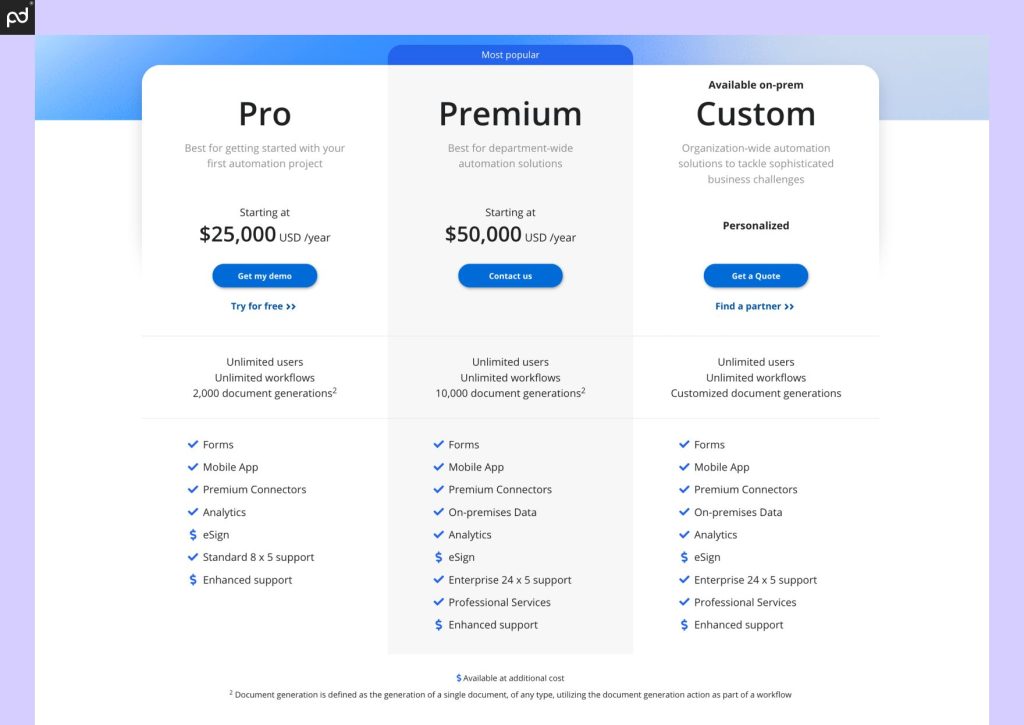
By our estimation, it would take nearly 50 users on DocuSign’s Business Pro plan to match the annual cost of Nintex’s Automation Cloud.
Nintex eSign is primarily designed as a supplemental add-on for Nintex users who already leverage the company’s Automation Cloud and/or DocGen software solutions.
In these scenarios, Nintex eSign provides authentication and digital signing functionality to generated documents.
Users can generate documents using other Nintex tools, then have those documents securely signed in one place.
Unfortunately, it’s difficult to gauge the true cost of Nintex eSign due to the platform’s pricing structure and its intent as a paid add-on.
Although Nintex Automation Cloud supports unlimited users, document generations are limited and e-signing incurs additional costs.
In every scenario, it’s safe to say that the pricing structure around Nintex will largely eliminate all but enterprise-level organizations seeking to bring hundreds or thousands of team members onto the platform.
Our suggestion
Due to the pricing implications surrounding the Nintex platform, DocuSign will be a better fit for any user who isn’t operating at the enterprise level.
Even when considering the additional charges to raise transaction limits and sending restrictions on DocuSign plans, it’s unlikely that the price will match the cost of the Nintex platform.
On the other hand, organizations with hundreds of users, who are looking for both automation workflows and e-signing solutions may find Nintex to be a better fit.
- DocuSign will be a better fit for the majority of teams, due primarily to cost and use case.
- Nintex will make sense for organizations with dozens of users and an interest in more than just e-signing tools.
- PandaDoc and other solutions offer a middle ground by assisting with more than just e-signing while keeping prices competitive for teams of all sizes.
E-signing process
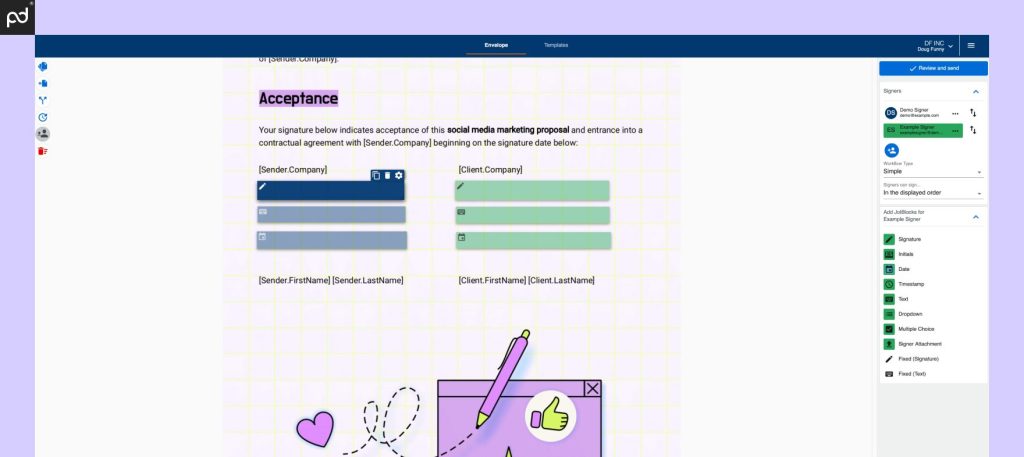
While e-signature processes can vary greatly between platforms, DocuSign and Nintex eSign share a very similar flow.
Users can upload documents to either platform and prepare them for e-signing using drag-and-drop tools.
Documents are sent using the platform and progress can be tracked using the internal dashboard.
This sort of tracking is different from what you’d see in a platform like PandaDoc, where our document analytics help users analyze how recipients viewed and interacted with each page of the document.
Instead, this type of tracking lets you know when a document was viewed and when it was signed, similar to a live audit trail.
It’s a key part of document management and something commonly shared by most e-signing platforms.
Once documents are signed and completed, they are stored on the platform and can be downloaded at any time.
Outside of the basic upload process, both platforms can also accept documents from integrated channels.
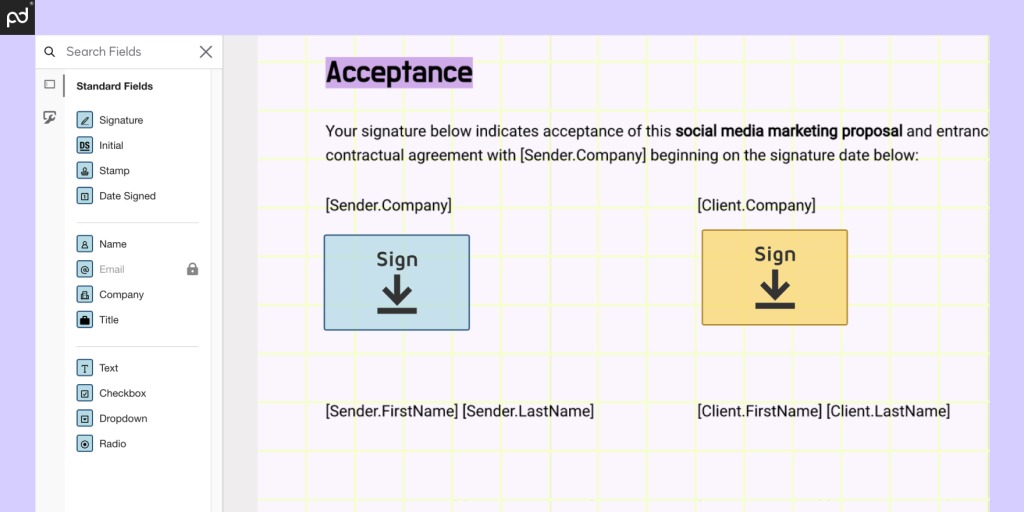
Nintex users are more likely to experience this from the very start, since Automation Cloud and DocGen for Salesforce integrate with Nintex eSign in a very natural way.
However, DocuSign users can also take advantage of similar workflows.
Users who have expanded into other DocuSign products, like DocuSign CLM or Docusign IAM will find seamless integrations with DocuSign’s e-signing tool.
Even without these methods, DocuSign users can integrate with hundreds of applications and software tools (including Salesforce, for enterprise users), allowing for quick and easy handoffs between those platforms and their data.
While other platforms (like PandaDoc) also allow for a similar process using document integrations, Nintex is very limited in this scope.
Our suggestion
When examined from the perspective of process, these e-signing platforms are relatively similar in terms of workflow.
Naturally Nintex users will gravitate toward using the Nintex platform.
Teams who haven’t moved to the Nintex ecosystem are likely better served with DocuSign or highly integratable e-signing solutions.
- Both platforms can handle documents provided via direct upload, and the workflow is largely the same.
- Nintex is a better fit for Nintex users, a design philosophy encapsulated by the “all-in-one-place” product approach.
- DocuSign is best for users with a diverse tech stack and provides a host of integrations to make handoffs simple and easy.
Extra features
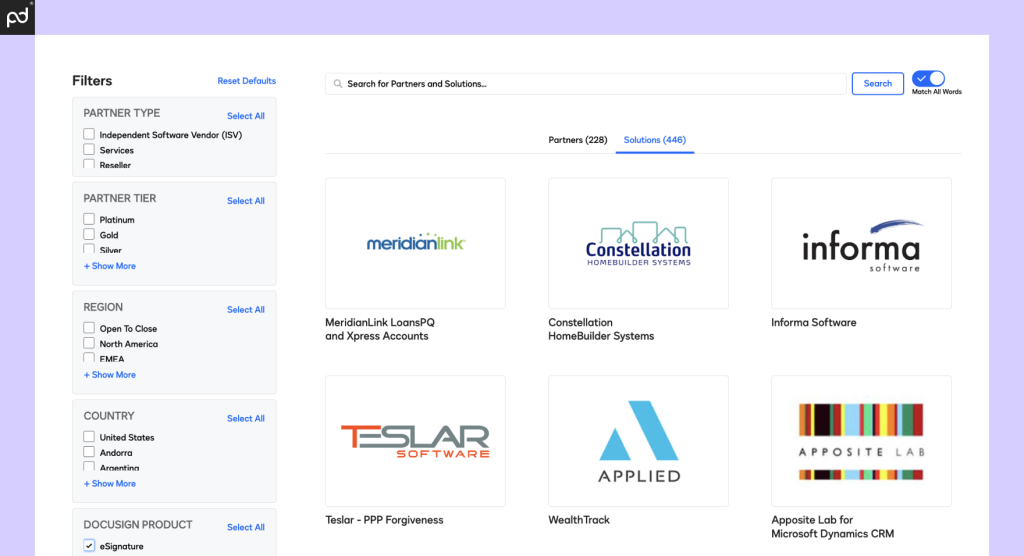
While Nintex eSign and DocuSign are built for digital signature capture, many e-signing platforms often include additional features to streamline the e-signing process.
DocuSign offers a broad selection of such features (although not as many as other dedicated signing platforms) including payment capture, customized branding for multiple brands (enterprise level only), embedded form creation, and collaboration tools.
Chief among DocuSign’s feature set are its integrations.
The platform integrates natively with over 600 applications, including obscure software solutions in niche industries.
While more popular integration options like Salesforce, Microsoft Dynamics and Netsuite are limited to enterprise plans, other integrations are available for every paid plan.
Unfortunately, Nintex users won’t enjoy as many perks and extra features due to the fact that most of these components are managed by other software tools on the Nintex platform.
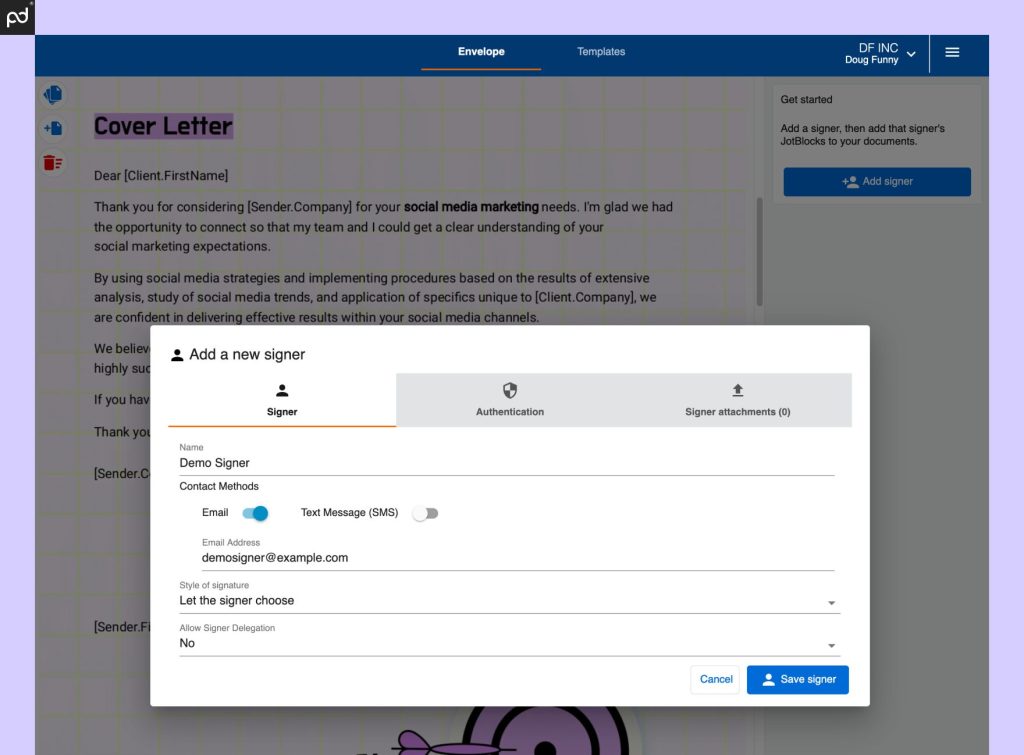
Where DocuSign and other competitors offer robust integrations or additional features, much of this is handled by other Nintex software.
While Nintex eSign supports signer attachments, bulk sending/signing, and similar features (all of which are available with DocuSign), form creation, analytics tools, data integrations, and more are handled by the platform’s Automation Cloud or DocGen tools.
This further narrows the scope of Nintex eSign to a straightforward e-signing tool.
Considering its primary use-case as an add-on/supplement for the rest of the Nintex ecosystem, it stands to reason that most users will already have access to the additional features that DocuSign only includes with upgraded plans.
Our suggestion
While both Nintex and DocuSign offer similar functionality in their e-signing platform, DocuSign brings more to the table in terms of extra perks and features.
For users within the Nintex ecosystem, this hardly matters since those additional features are handled by other systems.
- DocuSign offers features that go beyond simple e-signing, enabling users to do more with the platform when using higher-tiered plans.
- Nintex offloads these features to other Nintex software, so users will have access to similar features by default.
- Unlike PandaDoc and other competitors, neither platform greatly expands the scope of its e-signing functionality.
Alternatives to Nintex and DocuSign
While Nintex and DocuSign both offer great functionality at the enterprise level, they come with a few downsides. Nintex is expensive, and DocuSign is squarely focused on electronic signature capture.
However, they aren’t the only e-signing platforms on the market today.
Here are a few other SaaS solutions that can easily scale to the enterprise level as your organization grows.
- PandaDoc.
- Dropbox Sign. (Formerly HelloSign.)
- Adobe Acrobat Sign. (Formerly Adobe Sign.)
- GetAccept.
- SignNow.
Each of these tools offer a clear signing process and hold certifications around security and authenticity for digital signatures captured on their platforms.
Some tools, like PandaDoc and GetAccept, are designed around proposal generation and sales enablement, vastly expanding the use case for the software and inviting users to consolidate their tech stack.
Other tools, like Acrobat Sign and offer unique perks like PDF editing (Adobe) or the ability to integrate with much larger automation systems (SignNow).
Before you jump in with DocuSign or Nintex, take a look around and see if other platforms are a better fit.
PandaDoc helps you build better documents
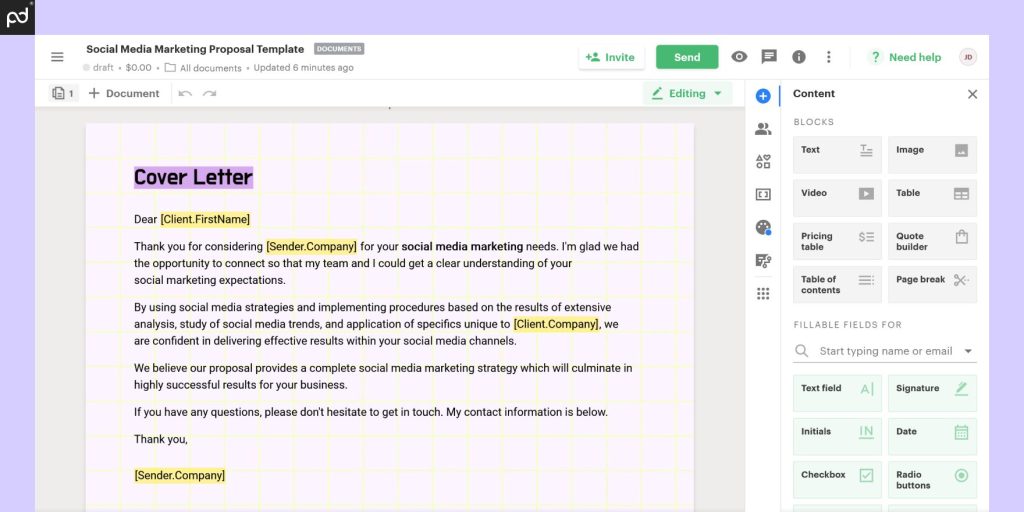
Still not sure about Nintex or DocuSign? While both are great signing solutions, you won’t be able to do much more with them than that.
If you’re looking for the ability to empower your document workflow, PandaDoc is the better choice. We offer an end-to-end, collaborative document creation process that can be handled in your browser window.
Here’s a closer look at what to expect with PandaDoc:
- Powerful document creation. Create professional-looking documents completely from scratch.
- Advanced workflow. Automate document routing, approvals, and reminders to eliminate manual tasks and reduce errors.
- Seamless e-signing. Collect legally binding e-signatures on any device. Includes real-time tracking and notifications.
- Extensive integrations. From CRMs to productivity tools, add your document workflow to the rest of your tech stack.
- Affordable pricing. Choose a plan that fits your budget and scale as your business grows.
The best part?
You can try it out for yourself with a free 14-day trial or book a demo with our team for a personalized tour.
Come and see why thousands of businesses around the world build better documents with PandaDoc.
Disclaimer
Parties other than PandaDoc may provide products, services, recommendations, or views on PandaDoc’s site (“Third Party Materials”). PandaDoc is not responsible for examining or evaluating such Third Party Materials and does not provide any warranties relating to the Third Party Materials. Links to such Third Party Materials are for your convenience and do not constitute an endorsement of such Third Party Materials.
Originally published September 30, 2021, updated August 16, 2024


